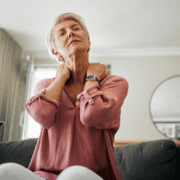Six Ways to Keep Your Thanksgiving Festive and Fit
Thanksgiving is one of my absolute favorite Holidays.
I love all the food, sweets, time with family, the Macy’s Day Parade, afternoon naps, and football. While it’s historically been a time for indulgence and relaxation, more and more people are opting for a more active and healthier Thanksgiving Day.
And there are numerous benefits for doing so…boosted mood and energy levels, improved digestion, happier joints (hips, knees, back, neck, shoulders), and you’ll offset some of the extra calories you may have consumed.
If you’re looking to have a festive, but perhaps more fit Thanksgiving Holiday this year – read on for seven tips and ideas:
1. Practice Mindful Eating
You can still enjoy your Thanksgiving meal – but simultaneously support your health and digestion – with mindful eating. Mindful eating is the practice of paying full attention to the experience of eating and drinking. It involves slowing down, savoring each bite, and tuning into your hunger and fullness cues to create a more enjoyable and intentional eating experience.
Studies show that eating slowly and savoring each bite can reduce calorie intake by up to 25%, as it gives your brain time to register fullness. Mindful eating also improves digestion because it promotes thorough chewing and reduces overeating, which can lead to bloating and discomfort.
Instead of piling your plate first-thing, focus on tasting each dish, and enjoying every moment of your feast.
2. Interrupt your sitting.
Hopefully after you’ve practiced mindful eating – you won’t feel so full – and will be less inclined to slump on the couch. But full or not, our bodies weren’t designed to sit for prolonged periods, so getting up frequently is an easy way to not only incorporate movement throughout your day, but to help keep away lower back and joint stiffness. I recommend standing up once every 30 min. This could be a fun “job” to give a young child at your Thanksgiving table. Make them accountable for watching the clock and remind you to stand up. Interrupting your sitting is possibly the easiest and most effective strategy to keep your knees, hips, and spine from getting painful and stiff on Thanksgiving Day.
3. Sign up for a Turkey Trot
Thanksgiving Turkey Trots are a popular event in most towns and it can be a really fun event for the whole family. Turkey Trots are typically 5K’s – or 3.2 miles. If you’re not able to sign up for an actual race, grab your friends and family and create your own Turkey Trot within your neighborhood. This is a great way to get your blood flowing and joints lubricated first thing in the morning. Plus, morning exercise kickstarts fat oxidation and can keep your metabolism elevated for hours afterwards – so this is a great way to energize your body while also balancing Thanksgiving Day indulgence.
4. Be Active during Commercials.
Whether it’s the Macy’s Day parade, football, or both – it’s easy to find yourself lounging for hours on a soft sofa or recliner – which can wreak havoc on your back if you’re not careful. A very easy way to keep yourself from sitting or slouching too much, and to incorporate some healthy movement into your day, is to get up and do something active during commercials. It’s the perfect opportunity to do a quick 2 min exercise or stretch – and it doesn’t have to be complicated. Choose from a quick set of squats, heel raises, planks, or back stretches. And make it fun. Get a plank or squat competition going with your most competitive family members – you know who they are.
5. Walk your Dessert Off
While skipping dessert is of course an option – you can also choose to walk it off. Opting for a post-meal walk has many benefits (even if you already did a Turkey Trot in the morning). It aids digestion, helps regulate blood sugar levels, and it’s good for your hips, back and knees. Plus – a post-meal walk is an opportunity to get some much needed lengthening and stretching of our muscles and joints after being parked in a chair for any length of time. Walking also happens to be one of the best and most natural exercises you can do for yourself – but it’s especially great to do after a big meal like Thanksgiving – and before you settle in for the evening.
6. Stay hydrated
Staying hydrated is important all of the time – but especially on a day like Thanksgiving. Good hydration will help regulate your digestion, which is particularly important given the heavy and often rich foods we typically consume on this day. Plus, water aids in breaking down food, allowing for better nutrient absorption and preventing digestive discomfort.
When it comes to appetite, we often mistake thirst for hunger, so when you stay hydrated (especially prior to your big meal), you have more control over your portions and are less likely to overeat. When you stay hydrated – it not only supports your body’s essential functions – but makes healthy choices easier – because your energy levels will be higher and your mind clear – two more things that staying hydrated helps with.
Well there you have it – seven easy ways to keep your Thanksgiving festive – while also helping you to stay a bit more fit and healthy. If you’ve got any kind of back, hip, knee, neck, or shoulder pain that is keeping you from practicing these easy tips – I recommend talking to a mechanical pain expert. They’ll help you figure out the root cause of your problem and most importantly – help you keep it gone – so that by next Thanksgiving – we won’t even be having this conversation.
Are local to Portsmouth, NH?
CLICK HERE to connect with one of our specialists—just in time to enjoy the Thanksgiving holiday to the fullest!
It’s also the perfect time to take advantage of our BLACK FRIDAY SALE! Get our lowest prices of the year with our Physical Therapy Specialists and Regenerative Shockwave Therapy. CLICK HERE to sign up today to get full access to these deals – packages are limited and available only while deals last!
Dr. Carrie Jose, Physical Therapy Specialist and Mechanical Pain Expert, owns CJ Physical Therapy & Pilates in Portsmouth and writes for Seacoast Media Group. To get in touch, or request a copy of her free guide: 5 Simple and Easy Ways to Get Rid of Back Pain, CLICK HERE or call 603-380-7902





